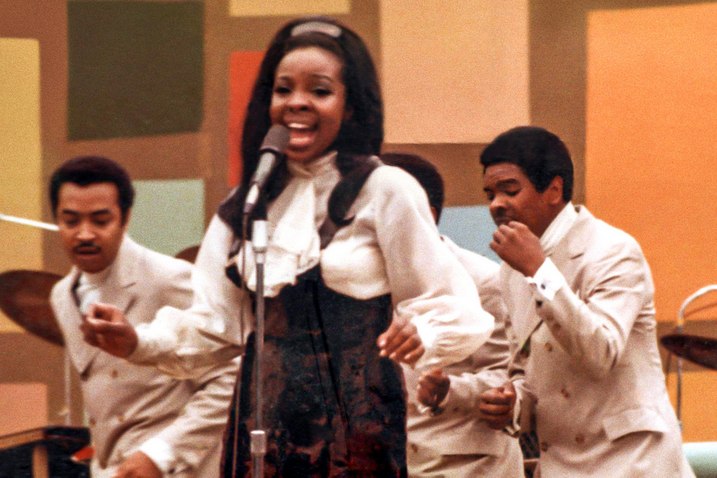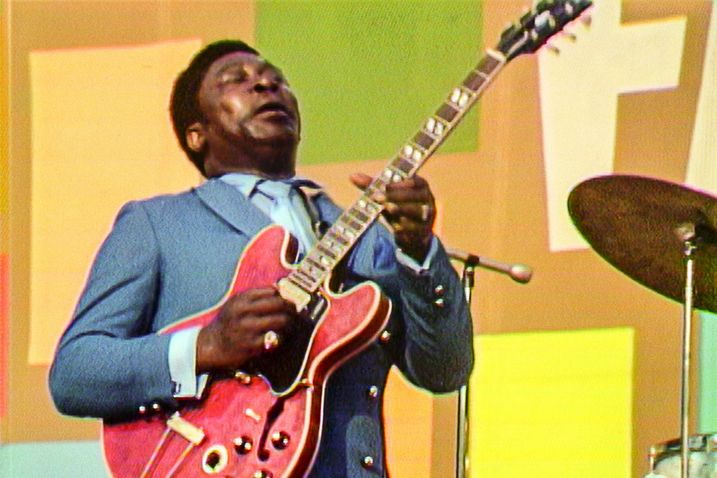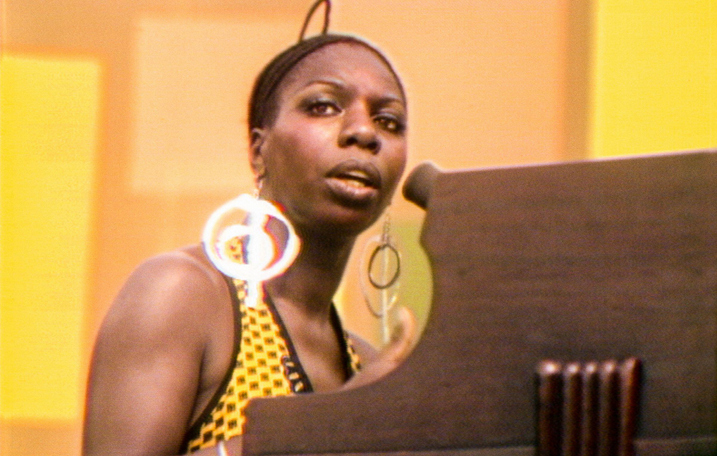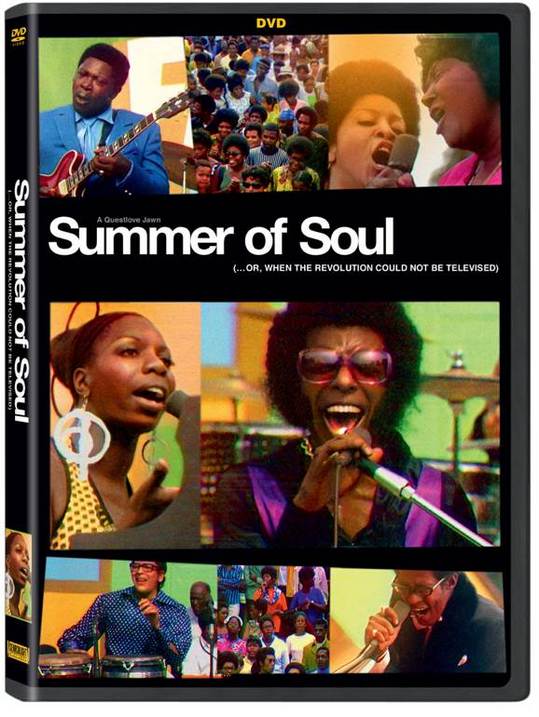Summer of Soul (…Or, When The Revolution Could Not Be Televised) (DVD Review)
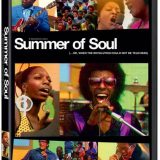 Just in time for Black History Month, my favorite film of 2021, Summer of Soul (…Or, When the Revolution Could Not Be Televised), has arrived in physical form. Yes, outside of Hulu and digital, I regret to say the film is currently only available in the DVD format. With that said, I have such a strong passion for what this documentary has to offer as both a piece of entertainment and a historical document. Two hours’ worth of footage concerning a concert nearly lost to time, and the context surrounding it provided me a lot of joy, and I can only continue to emphasize how much of a great experience this film is.
Just in time for Black History Month, my favorite film of 2021, Summer of Soul (…Or, When the Revolution Could Not Be Televised), has arrived in physical form. Yes, outside of Hulu and digital, I regret to say the film is currently only available in the DVD format. With that said, I have such a strong passion for what this documentary has to offer as both a piece of entertainment and a historical document. Two hours’ worth of footage concerning a concert nearly lost to time, and the context surrounding it provided me a lot of joy, and I can only continue to emphasize how much of a great experience this film is.
–
Film: 




Just imagine a music festival that time has seemingly forgotten. People may have some memories of it, but with a lack of much evidence beyond some photos and recollections, what if something huge happened, featuring the biggest R&B and Soul artists of the day and serving as a symbol of Black pride, only to leave almost no trace behind?
Back in 1969, more than 300,000 people attended the Harlem Cultural Festival, a series of concerts held over six weeks during the summer. It was filmed, and then the footage sat in a basement for 50 years. Fortunately, for his directorial debut, Ahmir “Questlove” Thompon of The Roots crew has assembled this excellent documentary. Thanks to his efforts, many of the performers, icons of the time, various notable figures, and attendees are all able to add their perspectives on how that day reflected so much of Black history.
Alternating interview footage with concert clips, including lengthy segments of the various performances, Questlove makes an entire spectacle out of an event that must have captured so much of the Black experience back in the day. Not being one to settle on just this fantastic footage, thanks to interviews and the use of even more imagery, Summer of Soul does what’s necessary to place this event within the context of history.
At this point in time, the Harlem Cultural Festival took place after the assassinations of Martin Luther King Jr., Malcolm X, and the Kennedys. Want to hear something even wilder? One of the concerts occurred on the same day as the moon landing. Yes, that momentous event for mankind was a huge deal, but as described by one of the attendees during the concert, there’s meaning to what was going on in Harlem that is just as important. There’s the thought of what other use the money spent on rockets could have gone to regarding the people on this planet.
At a time of uncertainty for many in the country, this was a period of time where people of all cultures gathered out of a shared love for the music. While the added understanding of this moment in time keeps certain undercurrents in mind (racial tension has a way of being continually notable), there’s ultimately a celebration of talent taking place, benefiting people wanting to have a great time and feel seen.
Described by many as “The Black Woodstock,” the performers seen and heard from at this concert features no shortage of greats, including Stevie Wonder, Gladys Knight and the Pips, Sly and the Family Stone, Nina Simone, The 5th Dimension, B.B. King, and Mahalia Jackson & Mavis Staples performing “Precious Lord, Take My Hand” together. It’s honestly an embarrassment of riches when it comes to the talent on display. And that’s not all. Black civil rights leaders like Jesse Jackson and New York City mayor John Lindsay (a white Republican politician who was very supportive of the Black community – what a different time!) were on hand as well. This festival truly seemed like a spectacular experience to be a part of.
Given the racially turbulent times that surrounded today, it’s great to see such a strong focus on how this whole thing worked out as some sort of dream come true. Even with the explanation that Black Panthers were hired to safeguard the festival (as the NYPD was heavily distrusted in that area), there’s still a tremendous amount of effort to explain all the good times that were had. Various attendees are given a chance to provide endearing recollections of that day, with a screen featuring footage placed in front of them to enhance their memories and allow for genuine reactions.
As an aside, I have long held onto 2006’s Dave Chappelle’s Block Party as a favorite. While on a much smaller scale, the Michel Gondry-directed documentary took a look at a moment in time where Chappelle, with all of this fame, decided to throw a free concert featuring some of the great hip-hop and R&B acts of the time (this included a prominently featured Questlove). The blend of music, comedy, and genuine excitement in the crowd made for a great watch.
Summer of Soul is an exceptionally better version of that film in terms of what we are able to witness. It shows how an art festival could deliver a message through the music and those attending, whether as one only looking to be entertained or as one wanting to make a statement. Regardless, this all happened while keeping things in order and without significant problems, and we’re lucky to be able to see it.
If there’s any problem, it’s the wonder as to how this footage remained in hibernation for several decades, while Woodstock ’69 has been prominently seen and well-known for ages. That answer partially answers itself, but Questlove has no explanation for how this footage became unearthed. In the scheme of things, it matters little. What’s been described as “The ultimate Black BBQ” is just one of many fitting ways to look at this fantastic rediscovery of the Harlem Cultural Festival. Summer of Soul has all the pieces needed to make that experience truly sing. I can dig it.
Video: 




Encoding: MPEG-2 NTSC
Resolution: 480i
Aspect Ratio: 1.85:1
Clarity/Detail: Despite being an award contender that has appeared on tons of critics’ top ten lists, Summer of Soul was apparently not deemed worthy of an HD release, which is a true shame. As it stands, as a modern film (despite the archival footage), the results for this DVD release are fine. Given the restoration work for the concert footage, presenting a hi-def version of this concert would have been very welcome on a Blu-ray release. Here, the image is not as detailed as I know it would be, and while never outright bad-looking, it’s a transfer leaving much to be desired.
Depth: DVDs are flat in nature, but the interview segments do enough to show some proper spacing.
Black Levels: It’s a soft image overall, and while there are signs of crushing, the doc is still plenty visible when considering the darker details for a film primarily set outdoors.
Color Reproduction: Colors are pretty decent here. The saturated nature of the old footage combined with the more crisply shot modern interviews makes for an interesting blend.
Flesh Tones: Skin tones are natural enough and maintain consistency. The interviews, shot in close-ups, benefit best.
Noise/Artifacts: Given the nature of the doc, this film should be commended for doing so much to not have too many issues with the archival concert footage. That said, the modern-day interviews look terrific.
Audio: 




Audio Format(s): English 5.1 and 2.0 Dolby Digital, English 2.0 Descriptive Audio Language Tracks
Subtitles: English SDH, Spanish, French
Dynamics: Thankfully, the lossy DVD format did allow for a fairly strong 5.1 mix. There’s only so much to do with the music contained within this archival footage, but the process to bring it all back to life has been a huge benefit for those looking forward to what they would be hearing. There’s enough good layered work here to make for a fine balance.
Height: N/A
Low-Frequency Extension: Thanks to all of the music, there’s a nice bump from the subwoofer to take in from this main audio track.
Surround Sound Presentation: The mix is solid in playing with the various channels. It’s primarily center-focused, which is what I expected from a film comprised of 50-year-old footage, but it works well enough.
Dialogue Reproduction: Everyone is heard loud and clear, whether singing or speaking.
Extras: 




I suppose I should be happy that this DVD-only release, at the very least, received an audio commentary track. Along with two very brief featurettes, that’s a bit more than I could ask for, given the lack of a Blu-ray copy of the film to better represent this doc.
Features Include:
- Audio Commentary by Director Ahmir “Questlove” Thompson – Questlove offers an informative commentary track, covering his various choices for how to edit the film together, tidbits about the various artists (Questlove is pretty much a music historian already), and other information about putting this documentary together.
- Soul Searching (SD, 2:56) – Questlove briefly discusses what he wanted to achieve by putting together this documentary and the opportunity presented with all of the found footage.
- Harlem: Then & Now (SD, 2:51) – This all-too-brief extra features Questlove walking through Harlem (during the pandemic, so it’s pretty empty) and recapping what the documentary represents.
Summary: 




I first watched Summer of Soul during the 2021 Sundance Film Festival. It managed to go an entire year without being replaced as my favorite film of the year. Having seen the doc a few times now, I can genuinely say it’s my favorite feature of this young century but will have a certain staying power for what it represents. It’s a shame the film is not currently available on a physical hi-def release, but for what it is, the DVD does a decent enough job of presenting the film, with the audio commentary being a nice bonus. The film is worth watching regardless, and I hope anyone who picks it up can enjoy it.


